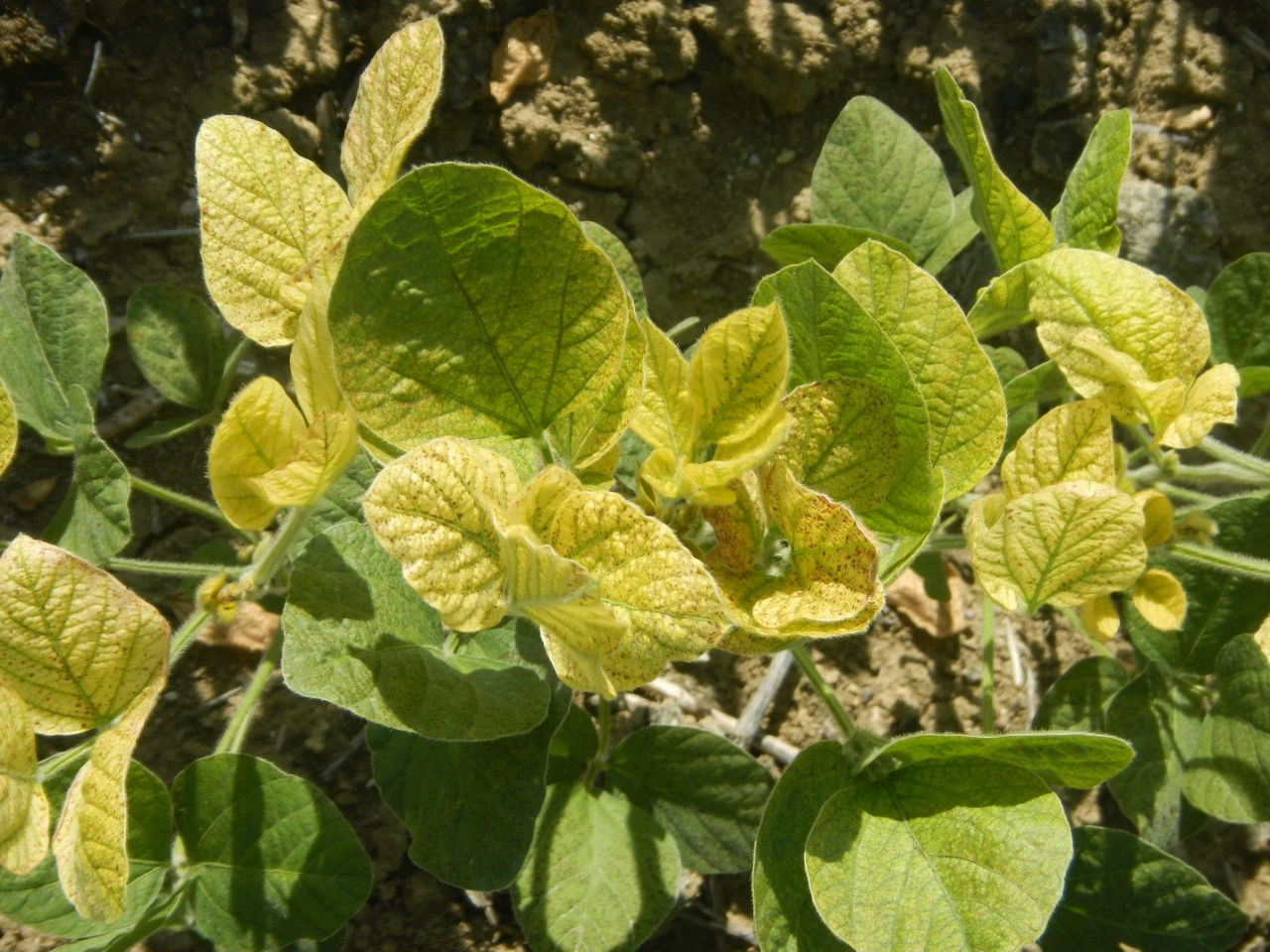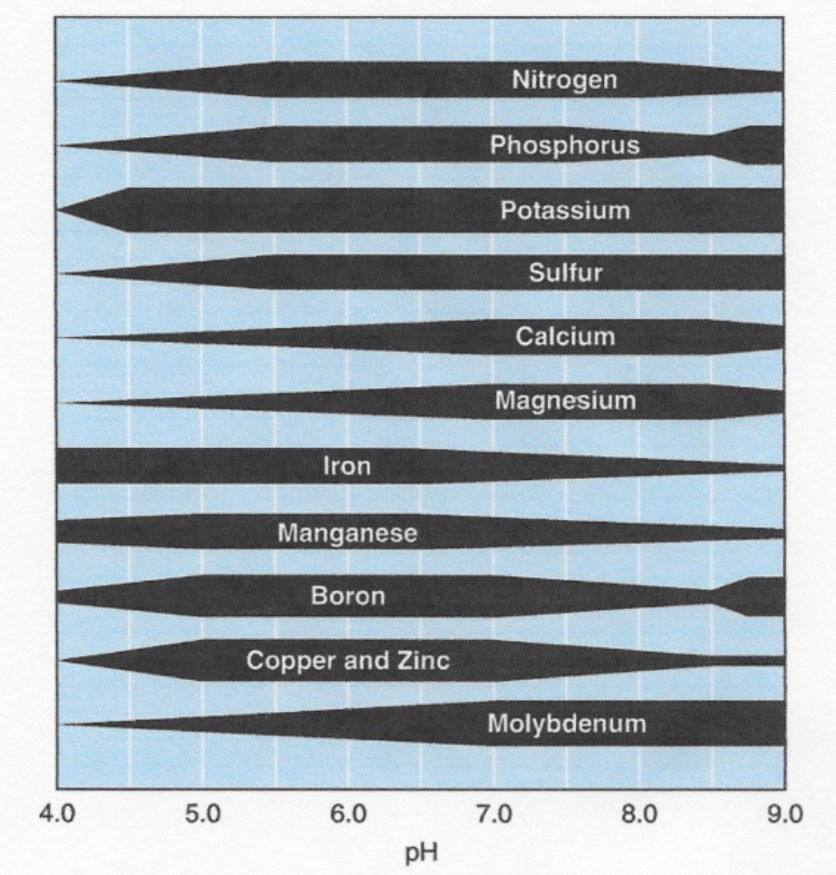3 MIN READ
Iron Deficiency Chlorosis
October 29, 2019
Iron (Fe) is an essential soybean micronutrient that is necessary for:
Chlorophyll development
Energy transfer
Plant transpiration and metabolism
Development of certain enzymes and proteins
Root nodule formation
Nitrogen (N) fixation.
A deficiency in Fe, called iron deficiency chlorosis (IDC), can cause substantial reductions in soybean yield. It is rare for IDC to affect an entire field; however, severely infected areas within a field may experience a 20 to 30% loss in yield potential1 (possibly more in some hot pocket areas). Iron-deficient plants are characterized by leaves that are yellow with dark-green veins (interveinal chlorosis) caused by the lack of chlorophyll development enzymes that require Fe (Figure 1). The symptoms typically appear on the youngest leaves between the first and third trifoliate growth stages.2 If IDC is severe, leaves may die and fall off the plant, reducing the amount of plant tissue available for photosynthesis, and the growing point may die.

Figure 1. Characteristic symptoms of iron deficiency chlorosis. Picture courtesy of Dr. Bobby Golden. Mississippi State University.
How IDC develops
Iron deficiency chlorosis is caused by the plant’s inability to absorb soil Fe. Soybean plant roots release acids into the soil that solubilize Fe+3 into the readily available Fe+2 form. In high pH soils with high levels of bicarbonates, Fe uptake can be limited because of chemical reactions between the bicarbonates and Fe. The deficiency is most common in soils that are poorly drained, have a high pH (alkaline), are calcareous, and have high amounts of residual N. Soils with finely divided lime (calcium carbonate) or high lime can cause IDC to be more severe because the calcium carbonate slowly neutralizes the acid excreted by the roots, which is meant to solubilize soil Fe (Figure 2). These conditions are typical to areas of Minnesota, the Dakotas, Nebraska, and Iowa. The deficiency arises because Fe is a rather insoluble element and becomes even less soluble under these conditions. Residual N is a factor because soybean roots can absorb nitrate-N regardless of the ability to fix N in the root nodules. When nitrate-N is absorbed, bicarbonate is released by the roots, which over time can increase soil pH and result in IDC symptoms.

Figure 2. Nutrient availability based on soil pH. Illinois Agronomy Handbook. Permission granted for use by Dr. Emerson Nafziger, University of Illinois.
Environmental conditions can result in IDC development. Wet soils can cause carbon dioxide and bicarbonate to increase in the soil, which neutralizes the acid excreted by soybean roots and interferes with Fe uptake. Additionally, research has shown that IDC is more severe when plants are subjected to cool temperatures.3
In areas where IDC is common, the amount of water lost to evapotranspiration (ET) tends to be greater than the amount of water that leaches through the soil profile. Therefore, solutes containing carbonate or salts collect on the soil surface instead of leaching through the soil, especially where water flows into field depressions. Iron deficiency chlorosis may be evident within the solute collection areas.
In fields with high amounts of residue (organic matter or manure), IDC may be more severe. Carbon dioxide released by the microbes feeding upon the residue results in an increase in bicarbonate, which again can increase soil pH and make Fe unavailable.
Managing IDC through genetics and stress management
Managing IDC is difficult, particularly in a growing crop. Where IDC is known to occur, or a soybean crop is to be planted into a field with high pH or that contains high salt and/or calcium carbonate content, soybean products with tolerance to IDC should be grown. Product selection should also include genetic qualities that can potentially reduce root and plant stress such as products with resistance or tolerance to nematodes and diseases. Seed treatments should be considered to help protect plants from insects and seedling diseases. Compaction can impair root growth; therefore, precautions should be taken to reduce the potential for compaction and appropriate tillage should be conducted to help remove compaction.
When IDC symptoms are observed and to rule out other causes that appear similar, soil and plant samples should be submitted to a lab for evaluation. Other causes for yellowish leaves include soybean cyst nematode feeding, diseases, waterlogged soils, sulfur (S), manganese (Mn), and magnesium (Mg) deficiencies, and lack of N fixation or soil available N.
A soil test analysis should be made for pH, percentage of calcium carbonate, and soluble salts. The Bray P1 test or weak acid test is a standard phosphorus deficiency test used in much of the Midwest while the Bray P2 or strong acid test is used to extract adsorbed forms of phosphate only and is for use with soils with a pH >7.5. The reason for testing for P is that rock phosphate is a tricalcium phosphate (has another Ca molecule tied to the phosphate molecule). The Bray P2 test measures unavailable soil P plus part of the soil active reserve P, and when its value is high, there is extra soil Ca, a higher pH, and the increased opportunity of IDC to develop because of high pH.
Consider using a seed placement method of an Fe chelate product that is in the ortho-ortho (EDDHAA) form. University of Minnesota research has found yield benefits of ortho-ortho chelated Fe with seed; however, using other Fe chelate products and application methods has shown inconsistent yield benefits. Maximum return on investment has been found to occur when these products are used in areas moderately to severely affected by IDC.4 Always consult the product label for rates and application information. Rescue treatments with Fe chelate sprays are not recommended or economical.
Other management considerations include minimizing nitrate carryover from year to year, targeting soybean crops to low nitrate soils, and planting a companion crop, such as oats. The companion crop may absorb excess nitrate-N and soil moisture to reduce bicarbonate build-up, possibly keeping soil Fe available for the soybean crop.4
In some situations, adjusting planting rates may also be a management option. Research has found that a higher seeding rate may result in less severe chlorosis and higher yield potential; however, this observation is limited to soybeans planted in wider rows, which suggests that row spacing is the most influential factor.5
Sources:
1Arp, A. 2014. Iron chlorosis continues to cause problems for Iowa soybean farmers. Iowa Soybean Association On-Farm Network.
2Iron deficiency chlorosis. 2014. Soybean Research & Information Initiative. http://soybeanresearchinfo.com/.
3Kandel, H. and Goos, J. 2011. Iron deficiency chlorosis in soybean. Crop & pest report. North Dakota State University. https://www.ag.ndsu.edu/.
4Kaiser, D.E. and Bloom, P.R. 2018. Managing iron deficiency chlorosis in soybean. University of Minnesota Extension. https://extension.umn.edu/.
5Goos, R.J. and Johnson, B. 2006. Seed treatment, seeding rate, and cultivar effects on iron deficiency chlorosis of soybean. Journal of Plant Nutrition. Vol 24: 255-68.8
Other sources:
Corn & Soybean Field Guide. 2014 Edition. Purdue Extension. Purdue University.
Franzen, D. 2012. Iron deficiency chlorosis in soybeans. Crop and pest report. North Dakota State University.
Morgan, J. 2012. Iron deficiency chlorosis in soybeans. Crops & Soils magazine. American Society of Agronomy. http://www.agronomy.org/.
Web sources verified 10/9/19.
1006_S3